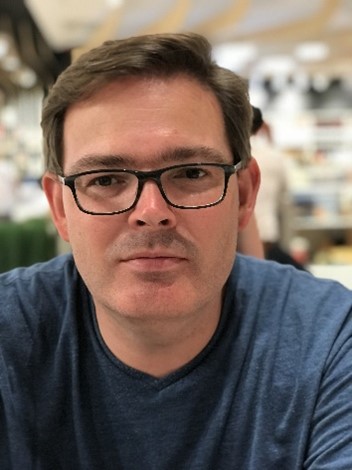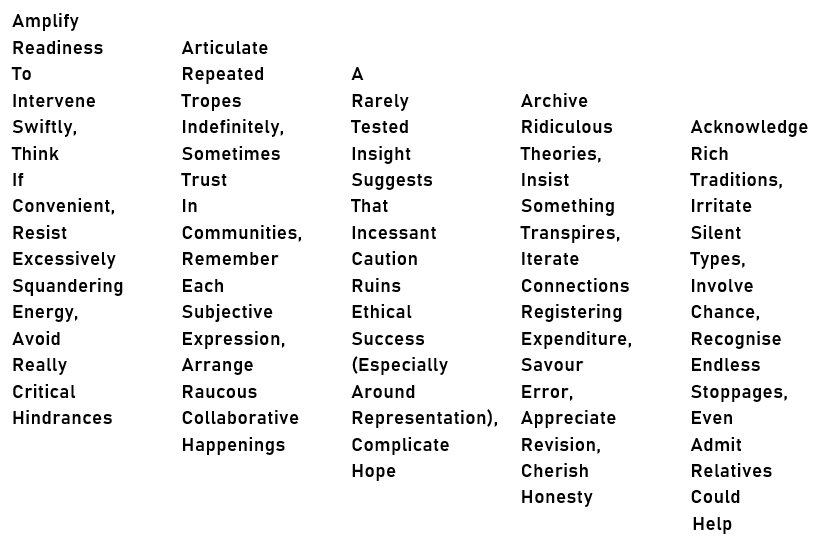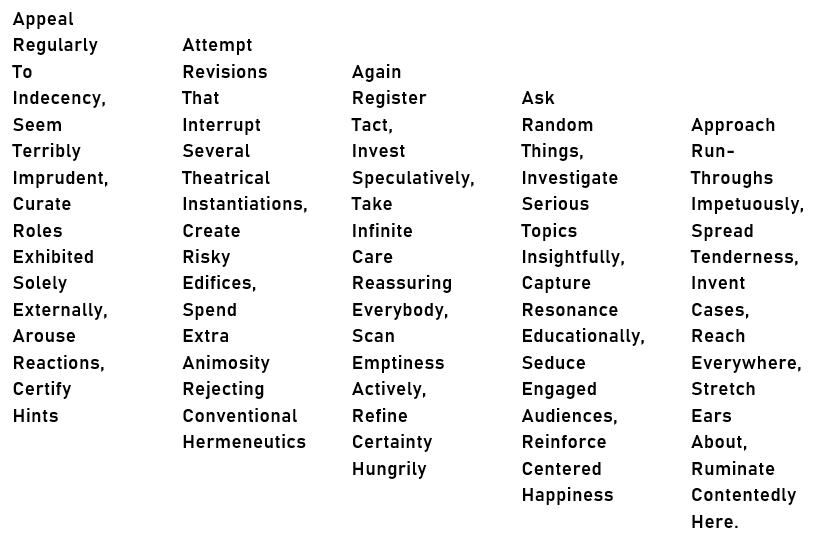Artistic research: Where are we today?
DOI: 10.32063/1003
Anthony Gritten
Head of undergraduate programmes, The Royal Academy of Music, London.
Questions
Question 1: What is artistic research? What characterizes good artistic research? Can you give one example of excellent artistic research?
Question 2: How far have we come in establishing a relevant practice for artistic research regarding criteria for admission, (methodic) approach and assessment?
Question 3: The following quotation is from Manifesto of Artistic Research: A Defense Against Its Advocates (Henke et al.):
Since its beginnings in the 1990s, artistic research has been driven by politics. Without the strict academicization of courses of study in art and design as furthered by the Bologna Reform, the entity we call ‘artistic research’ could hardly have come into existence.
How would you judge the nature and consequences of the politically driven institutionalization of artistic research? Was there a thing called artistic research before the Bologna Reform, or is it simply a bureaucratic invention? In fact, is artistic research the last step in the steadily growing academization and institutionalization of the art field?
Question 4: What is research in artistic research and how does it differ from what groundbreaking artists have always been doing?
Question 5: For whom is artistic research? Who is expected to benefit from the projects and their outcomes? How should the outcomes ideally be communicated or disseminated?
Question 6: What kind of shared knowledge does artistic research produce and (how) is it falsifiable?
Question 7: In his book Artistic Research Methodologies, Mika Hannula writes that the artistic researcher must ‘develop and perfect her own artistic skills, vision and conceptual thinking … contribute to academia … by proposing an argument in the form of a thesis … and communicate with practicing artists and the larger public, performing what one could call “audience education.”’ Are the expectations to the artistic researcher both too high and hazy?
Question 8: Should artistic research be critical, or even subversive? And if yes, how and why?
Question 9: What are the challenges for the development of artistic research? Considering the development of the field so far – do you see specific areas in need of change or strengthening? Where would you like artistic research to be in 10 years?
Question 10: What can platforms such as Music & Practice do in order to help the development of artistic research?
by Anthony Gritten
Music & Practice, Volume 10
Enquête: Departing safe harbour
More than a decade ago, not long before the birth of this journal, Coessens, Crispin and Douglas published a book-length summary of what they termed The Artistic Turn. Returning to port on the final page, they nailed their colours to the mast with the following four essential imperatives: ‘Never forget the origin [ … ] Deterritorialize the research space [ … ] Search for a possible discourse [ … ] Search for the hidden dimensions and different perspectives’.[1] These imperatives were phrased in matters of only a few syllables, starkly emboldened on the paper, and centrally aligned on the page all the better to drive themselves home into the cultural consciousnesses of practitioners. The mass of blank white space surrounding them allowed the reader’s thought to gather itself while the syllables faded from her lips. In the decade since The Artistic Turn settled in its moorings, a tsunami of activity has swept inland and redrawn the map of research into art making, even in music. New passages and channels have emerged and coalesced under various headings – Practice as Research, Practice Research, Performance Studies, Performance Philosophy, Artistic Research, and so on – and the affordances of the new fields are evolving, adapting, regrouping and bending in the drifting ebb and flow of academic currents. Every now and then, new eddies of activity and collaboration support a degree of personal development and institutional solidity. Doctoral programmes have been lifeboats for emerging artist-scholars – though imposter syndrome still occasionally haunts the footlights of the new stages that are opening up.
In the spirit of the disciplinary energy funnelled by The Artistic Turn, this short text first answers one of the questions posed by the editors of Music & Practice, and then casts back out to sea with a set of mini-manifestos: Do this! While these ten injunctions celebrate the journal’s tenth birthday, each one is leaky and proliferates into smaller phatic imperatives (45 in total), quite unlike the well-formed literary dicta offered by Coessens, Crispin, and Douglas. The imperatives are fluid, easily diluted, and do not need to be remembered. If they but lap up against the edge of a qualia of an artistic research project that you recognize, then that will have been sufficient.
First, though, some remarks on the editors’ Question 5, which asks the following: ‘For whom is artistic research?’ This is a Nietzschean question. It could be read as this: ‘For whom is this an example of artistic research?’, pointing at a particular case study. Or as this: ‘For whom is artistic research meaningful?’, pointing at the audience targeted by the event and their needs and tastes. The question could also be phrased thus: ‘For whom is artistic research happening right now?’, thereby focusing on ethnographic matters. The following remarks twist the question slightly differently, reading it as an ontological question: ‘For whom does artistic research become artistic research?’ Or in reverse, ‘Artistic research becomes artistic research for whom?’. In other words, this question is taken as pointing in this instance towards the phenomenological constitution of the event itself. By what means does something become artistic research?
Whichever way the question is twisted or unpacked into its constituent parts, it does not surrender to an easy answer. It might be assumed that the audience for artistic research is largely the same audience as sits through conventional artistic performances, in the sense that both events have artistic activity at their core. However, there are significant differences between artistic research and simple artistic events – not that these are ‘simple’ at all, of course; it is the manner in which artistic research is non-simple that is at issue here. Artistic research is more complex than the linear addition of a simple artistic event and a targeted description of it provided by its practitioner, whether the description be a compact 300-word explanatory statement written for a line manager or external auditor, or something more meaningful. Artistic research requires that the event’s academic paraphernalia – its evidence, problematics, research questions, existential transformations, self-assertions – be central to its identity, function and interpretation. The paraphernalia are shifted from the green room to the stage, from the supportive infrastructure of the production to the media content, from the periphery to the focus. This happens when artistic research is named: not when it is described, but when it is named: This – pointing to a particular case – is artistic research.
The naming of artistic research is performative. It functions the same way for nautical vessels: I name this ship the QE2. It requires a collaborative effort from both the artist and her audience (which does not necessarily mean a public announcement; it is more a matter of how the relevant materials are framed and what research questions are included within the framing). If artistic research is not named as artistic research, then its materials trickle back into the drifting ocean of simple artistic events. Artistic research is artistic research to the extent that it maintains its head above the water of simple artistic events. This nominalism is not treading water but active and continuous throughout the life of the artistic research project. It is partly a function of the institutional and disciplinary history of artistic research over the last few decades, but it is more significant than the mere institutionalization and disciplinary assimilation of yet another creative movement, and it is not about which name per se is used, notwithstanding internecine arguments about the comparative euphony of various monikers: e.g. Practice Research or Practice as Research. This is for the crucial reason that the performative naming of artistic research – which contributes to the establishment of the reality of the referents in question, to bend Lyotard’s terms in The Differend (§§47–93) – is itself central to the aesthetic and artistic processes to which the practitioner is committed and in which she invests time and energy. Equally, it is not the case that we are all artistic researchers now, and it is not the case that every artistic activity that is self-conscious is thereby artistic research. The performative naming of artistic research is not the mere appropriation of an extant entity; the naming of artistic research brings it into existence, establishes its constitution as an event, and thereby what might otherwise have been a ‘simple artistic event’ is transformed and no longer recognizably ‘simple’. The question is asked: Is this artistic research? There are as many names as there are practitioners doing artistic research; there are probably as many forms as there are artistic research projects, since, being existentially motivated, artistic research is characterized by its evolving multiple singularities. No two artistic research projects are the same, in the sense that two performances of, say, Schubert’s ‘Der Lindenbaum’ at the Wigmore Hall can be said to be more or less the same.
Artistic research, then, is not for audiences in a conventional sense, and it is not for conventional audiences. This is not a criticism of conventional audiences, insofar as there is such a thing as a ‘conventional’ audience that can be generalized away from actual examples. Quite reasonably, conventional audiences want magic, secrecy, surprise, revelation, imitations of pain and narratives of its subsequent amelioration; and such qualia constitute the basis for a particular type of artistic experience geared around the expectation that certain types of events will happen. In contrast, artistic research is constituted by a different set of qualia, and it is not for the faint-hearted or audiences who desire mere entertainment: it is for those who are also open to participating in anatomical dissection, public audit, and messy debate. It is not, though, that the artistic event at the core of an artistic research project is not intended for an audience; it is simply that the action by which an artistic event is named as artistic research is itself not one of the processes with which the conventional audience is primarily interested (its desire for magic and so on brackets such knowledge claims in order to focus on other important experiential aspects of performance). And it is not that simple artistic events do not document their results, for, of course, they have always documented themselves in great detail, regardless of the supplementary demands of funders and other auditors; but the additional ballast carried by artistic research is the requirement to also document the inputs to and processes of the artistic activity: with performative naming comes archival responsibility. This is perhaps one reason why artistic research has thrived in Higher Education, where the more or less transparent logic of pedagogical learning outcomes can easily be adapted to artistic research projects.
The performative naming that constitutes artistic research can, along with the practitioner’s deliberate provision of numbered research questions, data archives, audio-visual files, confessions of personal transformation, and sketches of the directions that hermeneutic interpretations of the event might proceed, be thematized as materials for a secondary artistic event, as part of the practitioner’s self-articulation and existential transformation. In this case, though, they become something else and they are no longer themselves part of the action of naming by which the primary artistic event itself becomes artistic research. The act of naming is the paradox of pulling oneself up by one’s bootstraps, and it is felt in an existential register by every practitioner of artistic research, but it is not itself part of the primary artistic event at the core of the project. (The assumption here is that all artistic research projects must terminate in an artistic event of some sort, must explicitly acknowledge the artistic event at their core, and must hang their research questions around at least the implied shadowy presence of an artistic event.)
This distinction between artistic research and the primary simple artistic events at their core is congruent with the social setting of artistic research, namely that its processes and outcomes should be documented and disseminated in an appropriately public manner. The materials of artistic research, insofar as they are used in an artistic research project, are docked in specific relation to communally approved criteria, and are available for logging (disciplinary and institutional peers need to judge, however crude and ad hominem) and archiving (research questions need to be shut down with research answers, however small-minded). Although the previous sentence phrased docking, logging and archiving in a slightly big-brother manner, there is nevertheless a serious democratic desire at the core of the artistic research project: the practitioner desires for her artistic activities, actions, questions, answers and outputs to be held to public account, not left to permeate and resonate privately. The important consequence of this social configuration is that, in effect, the proper audience of artistic research is the motley crew of collaborators, co-workers and other citizens who involve themselves in the process from varying distances – co-performers, producers, funders, reviewers, critics, managers. The rise of artistic research has allowed Higher Education to manufacture and monitor its own creative culture.
In this respect, artistic research can be said to strap itself into contemporary life in the developed world (networked, switched on, consuming, self-positioning) and to function not simply as a stage for its practitioner’s artistic experiments or as respite from the choppy waters of conventional public performance, but also as an occasion for genuine social leadership – for the exercise of artistic responsibility. In fact, without pushing the boat out too far, one might say that practitioners of artistic research do what contemporary politicians are seemingly unable to do: maintain systematic (or at least consistent) records of their actions that relate to the actions themselves in communally acceptable, empirically demonstrable and socially transformational ways. First, political records, as with artistic research records, should be communally acceptable: they should contain data that the community deems appropriate for the politician (read: artist researcher) to engage with. Secondly, political records, as with artistic research records, should be empirically demonstrable: data should be clear in order that the public can make judgments about political success. Thirdly, political records, as with artistic research records, should be socially transformational, which means something like the following: they should triangulate between the records of actions and the actions themselves, they should interrogate the dynamically evolving relationships between actions and records, and they should help citizens (read: the artistic researcher’s audience) both individually and collectively to contribute to the accumulation of social capital. In short, it is hardly metaphorical to suggest that, in society the relationship between communities and politicians (between the audience and artistic researchers) is not merely communal, it is also genuinely collaborative. This is to say that practitioners and audiences (politicians and voters) do not merely share space, they also curate that space together. In such a social contract, when it is shipshape, it is fair to say that both parties are creative.
This said, what is being proposed in the preceding paragraph is neither that the practitioner of artistic research should be a politician, nor that they are even obliged to be political, in the sense of subscribing to a specific political position and deliberately ensuring that this position informs their artistic work in one way or another. Both such proposals are certainly possible. Rather, the artistic researcher’s responsibility in each project is to the question, ‘Is this artistic research?’, and to answering this by performatively naming it as artistic research. The proposal, then, is that there might be a loose analogy between the activities of doing politics and doing artistic research: that they have an analogous ontology (the naming of artistic research and the election of politicians) and an analogous responsibility to their respective publics (audiences and voters).
So, to return in closing to the editors’ Question 5, ‘For whom is artistic research?’, and to drop anchor one final time, the answer to this question is: for all concerned citizens. It is for all those citizens who wish to contribute to and assent to its naming; to engage with the event’s academic paraphernalia; to see (in some cases) how academic funding can work; and to see (in all cases) how artists contribute to society beyond Higher Education. Such citizens – you readers! – are the practitioner’s valued co-workers.
We now depart safe harbour and head beyond the breakwater. The time of celebration is arriving: Happy birthday!
To celebrate the 10th birthday of Music & Practice, here are ten acrostics [please read vertically] as mini imperatives that propose a manifesto for the journal’s next decade.
[1] Kathleen Coessens, Darla Crispin and Anne Douglas, The Artistic Turn (Ghent: Orpheus Institute, 2009), 181 (bold in original).



